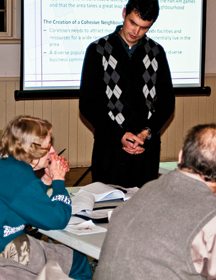By Duncan McAllister –
 The First Parliament site, transit, and planning—especially planning for the future of the Pan Am athletes’ village—remain top of mind with the Toronto Centre residents who attended a community round table hosted by Glen Murray and Pam McConnell in February.
The First Parliament site, transit, and planning—especially planning for the future of the Pan Am athletes’ village—remain top of mind with the Toronto Centre residents who attended a community round table hosted by Glen Murray and Pam McConnell in February.
Chris Drew, community planner with Murray’s office, shared a community action plan framework document for Corktown and the Distillery District. The plan was shaped by feedback received by his office regarding ongoing community projects. “One of them that came up quite consistently was heritage, and there was one project mentioned quite frequently, the First Parliament site,” he reports.
McConnell has been involved in the acquisition of the site for many years. “The last motion of the old city of Toronto was to try and acquire this property and we’ve been working on it ever since,” she contends, noting that the city persuaded one of the then-owners of the site to relinquish their interests via an expensive exchange of land and lease deals.
A real estate development concern owned by the Bresler family holds the remaining non-public interests in the site. McConnell maintains that it is time for governments to come together to create “another opportunity” for land exchange. “I think we should get it into public hands right now,” she says. “I’m a great believer in the right move at the right time.”
She sees the site as “a draw, a celebration space” and envisions the commemoration of the war of 1812 “bookended” with the Pan Am games. “There’s been up till now, not any interest by the Breslers to get off the land,” but hints that there may be signs of interest.
Transit was also one of the predominant issues. One area resident complains, “Our transportation is getting worse, not better.” Murray countered, “Connectivity within the neighbourhood and transportation is a priority. The provincial government has a 9.3 billion dollar commitment to transit right now in Toronto.”
Attendees also demanded concrete answers on the fate of the athletes’ village, which is being built to house competitors in the 2015 Pan Am Games, both during construction and after the event is over.
With “a brand new community to the south of us,” one resident asks, “what assurance can Murray and McConnell provide that the existing King and Queen streets won’t be ignored? How can community character be preserved and enhanced?”
Another participant questioned how the village is to be converted into family occupancy. “It’s going to be occupied by several thousand single people for less than a month.” His concern is that after the games, developers will market the property as small units, but “that’s not what Downtown Toronto needs.” He encourages them to build reasonably affordable, family-sized units, and “out of that will flow the necessity for the educational, health-care and recreational facilities that this community needs.”
“Otherwise,” the resident warns, “this is going to end up as another ghetto like west of Skydome.”
Parliament site split between public and private owners
According to Rollo Myers from the Architectural Conservancy of Ontario, the city has been trying to acquire the First Parliament site for over 15 years.
“The last piece, which is a big piece, is about half the size of the whole site and is owned by the Breslers,” says Myers, “There have been negotiations to offer them things to tempt them away. We’re hoping that will continue.”
Local resident Edward Nixon chairs the Old Town Toronto Network and has also been involved with the community initiative to acquire the First Parliament site for many years. He confirms that the publicly-held share of the site, formerly home of a Porsche dealership, is currently owned by the Ontario Heritage Trust.
Nixon and others plan to meet with Richard Moorhouse, executive director of the trust, about building a museum or community event space at the vacant site. “We’re going to be talking to [him] about the possibility of using that space, sooner rather than later, to actually do some things, and there are some community assets available to help assist in that process.”
 TheBulletin.ca Journal of Downtown Toronto
TheBulletin.ca Journal of Downtown Toronto

